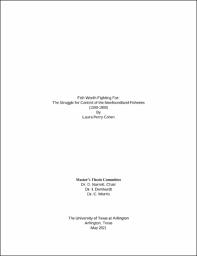
ATTENTION: The works hosted here are being migrated to a new repository that will consolidate resources, improve discoverability, and better show UTA's research impact on the global community. We will update authors as the migration progresses. Please see MavMatrix for more information.
Show simple item record
| dc.contributor.advisor | Narrett, David | |
| dc.creator | Cohen, Laura Perry | |
| dc.date.accessioned | 2021-06-01T17:33:41Z | |
| dc.date.available | 2021-06-01T17:33:41Z | |
| dc.date.created | 2021-05 | |
| dc.date.issued | 2021-05-13 | |
| dc.date.submitted | May 2021 | |
| dc.identifier.uri | http://hdl.handle.net/10106/29778 | |
| dc.description.abstract | The Atlantic cod that swam in the Grand Banks and along the coasts of Newfoundland played a significant role in the British Empire. The Newfoundland fisheries that developed following European exploration of the region in the early sixteenth century remained disputed areas for centuries. To Britain and France, the fisheries represented potential wealth and power, and soon, both countries were clamoring for rights to the island of Newfoundland and the waters surrounding it. During the eighteenth century, Britain and France engaged in several major wars against one another. Each war ended with peace treaties that included articles addressing the Newfoundland fisheries. The Peace of Utrecht in 1713, which concluded the War of Spanish Succession, granted Britain sovereignty over the island of Newfoundland, but France retained fishing rights. The Seven Years’ War ended with the signing of the Treaty of Paris in 1763 which transferred large areas of French North America over to British control. Despite Britain’s tremendous territorial gains and France’s considerable losses, both countries continued to occupy the Newfoundland fisheries, although the French possessions were considerably reduced. The American Revolutionary War brought significant changes to the British Empire. With the emergence of the new United States of America, three countries now had access to the Newfoundland fisheries as laid out in the terms of the Treaty of Paris of 1783. Each war and subsequent peace treaty brought diplomatic changes to the fisheries, but none of the peace treaties resolved the continual clash of empires in the fishing regions surrounding Newfoundland. The presence of the Newfoundland fisheries in every peace treaty between Britain and France throughout the eighteenth century highlights their value to those involved in the negotiations. Cartography depicting the North Atlantic region also contributed to the struggle for control of the area. Maps were used to support the various claims of European nations. The Newfoundland fisheries’ role in the British North Atlantic trade network demonstrated their importance to the emerging Empire. Throughout the eighteenth century, the fish that swam along the coasts of Newfoundland became fish worth fighting for. | |
| dc.format.mimetype | application/pdf | |
| dc.language.iso | en_US | |
| dc.subject | Newfoundland | |
| dc.subject | Fisheries | |
| dc.subject | British empire | |
| dc.subject | North Atlantic | |
| dc.title | FISH WORTH FIGHTING FOR: THE STRUGGLE FOR CONTROL OF THE NEWFOUNDLAND FISHERIES (1500-1800) | |
| dc.type | Thesis | |
| dc.degree.department | History | |
| dc.degree.name | Master of Arts in History | |
| dc.date.updated | 2021-06-01T17:33:42Z | |
| thesis.degree.department | History | |
| thesis.degree.grantor | The University of Texas at Arlington | |
| thesis.degree.level | Masters | |
| thesis.degree.name | Master of Arts in History | |
| dc.type.material | text | |
Files in this item
- Name:
- COHEN-THESIS-2021.pdf
- Size:
- 1.515Mb
- Format:
- PDF
This item appears in the following Collection(s)
Show simple item record


